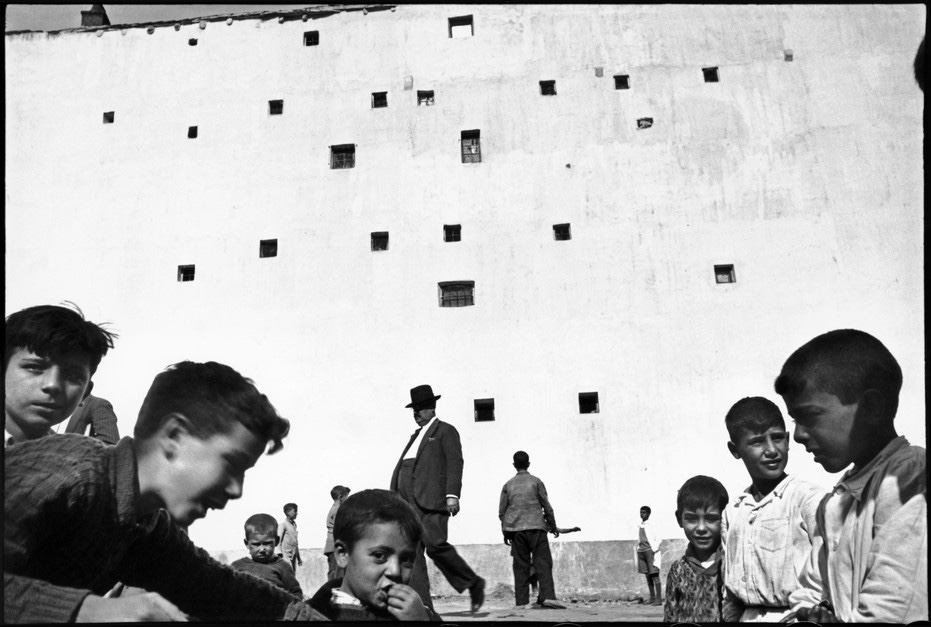Studying the work of Rene Magritte and the surrealists has given me a new-found appreciation for the masterful photos of Henri Cartier-Bresson.
Henri Cartier-Bresson and surrealism

Learn more: Free Ultimate Beginner’s Guide To Street Photography >
Henri Cartier-Bresson first considered labeling himself a surrealist photographer, but was suggested against it by Robert Capa, who co-founded Magnum with him. However, Henri Cartier-Bresson was trained in surrealism:
“Iʼm not interested in documenting. Documenting is extremely dull and journalism…Iʼm a very bad reporter and a photojournalist. Capa told me when I had an exhibition at the museum of Modern Art in ʼ46, he said no, heʼd be very careful. You mustnʼt have a label of a surrealist photographer. All my training was surrealism. I still feel very close to a surrealist but he said if you were labelled as a surrealist photographer you wonʼt go any further you wonʼt have an assignment and youʼre going to be like a hot house plant. Just forget it, do whatever you like but the label should be photojournalist. And Capa was extremely sound so I never mentioned surrealism, thatʼs my private affair. And what I want, what Iʼm looking for is my business. And Iʼm not a reporter. Its accidentally, itʼs on the side” – Henri Cartier-Bresson
1. Eternal life and death (circular composition)

For example in this photo by Cartier-Bresson, shot at a funeral of a late actor. Look at the circular motion and composition.

The symbolism: life and death is an eternal cycle.


Circular motion outlined:

This is also shot at a funeral, and look at all the women dabbing their eyes with the tissues:

Also see the three dimensionality and depth of their faces, and the direction of their faces and eyes (and ears as orientation of their heads):



René Magritte: Familiar Objects (1928)
I also was shocked to see this painting by Magritte, which bears an eerie similarity:

Also note the movement and placement and orientation of the faces:





See their faces abstracted as three-dimensional shapes, and look at the direction of their eyes:



Matisse: the dance (1910)

Even see how the composition of Henri Cartier-Bresson, with the circular composition mirrors that of Matisse, a painter Cartier-Bresson greatly admires.


Lesson: Circular composition
The lesson to apply in our street photography: try to place heads in a similar fashion, and have the circular motion, by placing some subjects closer to us, and others further. Also, to note the direction of the faces, to create a more three-dimensional view.
2. Repetition of rectangles, windows, and shapes

SPAIN. Madrid.
Probably one of my favorite Cartier-Bresson pictures. I love the surreal windows in the background, and the repetition of the rectangular window shapes, and the subjects in the foreground.



Which reminds me a lot of this painting by Magritte:
René Magritte: René Magritte, Golconda, 1953

See the repetition of the figures, and the repeating subjects.
3. Backs of head, and sense of scale

Similar to Giorgio de Chirico:

4. Life and death and children playing

The juxtaposition between life and death, and children:
Giorgio de Chirico, also has a similar concept:

5. Objects that look like something else

Making people look like objects, like how Henri Cartier-Bresson made this woman look like a key, coming out of a keyhole.

Learn more about Henri Cartier-Bresson >

Learn from the master, Henri Cartier-Bresson:
- 8 Inspirational Henri Cartier-Bresson Quotes on Photography, Composition, and Life
- Henri Cartier-Bresson Composition
- 5 Henri Cartier-Bresson Photography Composition Lessons
- 17 Lessons Henri Cartier-Bresson Has Taught Me About Street Photography
- 10 Things Henri Cartier-Bresson Can Teach You About Street Photography

